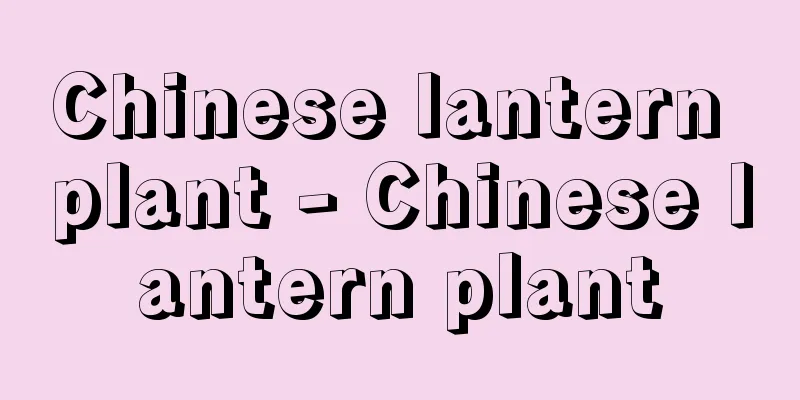Chinese lantern plant - Chinese lantern plant

|
A perennial plant of the Solanaceae family (APG classification: Solanaceae). It spreads by spreading its rhizome underground. It is 60-80 cm tall. The leaves are alternate, ovate, roughly sawtoothed, and have petioles. In June and July, white, five-petaled flowers, each about 2 cm across, bloom in the axils. After flowering, the sepals grow larger and encase the fruit, which turns a vivid crimson red when ripe. It is cultivated not only for its fruit, but also for the fun of squeezing the seeds out of the fruit and putting them in their mouths to make noise. The commonly cultivated variety is the large-fruited Tanba Nightshade, which is also planted in pots and flower beds. Other varieties include the short-growing Sanzun Nightshade and the Youraku Nightshade, whose bracts are lanceolate and hang down like spikes. In traditional Chinese medicine, the root is called sanshokon and is used together with the stems and leaves for cough suppressance, diuresis, and fever reduction. There are over 100 species in the Physalis genus. The common nightshade is an annual plant native to tropical America. The fruits are small, but green and grow in large numbers. There are also edible species, such as the European nightshade, native to Europe, and the Chinese nightshade, native to North America. To cultivate, the new shoots that grow in the spring are dug up along with their underground stems, and then planted in pots or in the ground in a sunny location. [Keiji Kanda July 16, 2021] Cultural historyIt appears in the Kojiki under the name Akakagachi, and is likened to the eyes of the Yamata no Orochi (Eight-headed Serpent). In the Heian period it was called Hohotsuki, and the name appears in the Honzo Wamyo and Wamyosho. In the Edo period, Tanigawa Kotosuga suggested that the name was derived from the fact that the fruit ripens to a red color, with "ho" meaning fire and "tsuki" meaning dyed. The game of inflating ground cherries is recorded in Eiga Monogatari. Ground cherries are usually found in the wild in human settlements, and some believe that they did not originally grow in Japan. In China, it was first found in the Han Dynasty's "Erya" and in herbal books such as the "Shennong Bencao Jing" (c. 500), it is said to be effective as a diuretic and antipyretic, and that although the leaves have a bitter taste, they can be eaten together with the fruit. In Japan, the fruit was pickled in salt during the Edo period. The yellow fruit of Physalis albicans is eaten raw or candied. [Hiroshi Yuasa July 16, 2021] Native to East Asia. There are many horticultural varieties, such as the large-fruited Tanba Nightshade. The roots, stems and leaves are used in herbal medicine. ©Seishohmaru "> Physalis From June to July, white, five-petaled flowers measuring approximately 2 cm in diameter bloom one by one in the leaf axils. ©Seishohmaru "> Physalis flower After flowering, the sepals grow larger and encase the fruit, which turns red in July and August. ©Seishohmaru "> Physalis fruit Source: Shogakukan Encyclopedia Nipponica About Encyclopedia Nipponica Information | Legend |
|
ナス科(APG分類:ナス科)の多年草。根茎は長く地中に伸びて繁殖する。高さ60~80センチメートル。葉は節ごとに2枚ずつついて互生し、卵形で粗い鋸歯(きょし)があり、葉柄がある。6~7月、葉腋(ようえき)に白色で径約2センチメートルの5弁花を1個ずつ開く。花期後、萼片(がくへん)は大きくなって果実を包み、熟すと鮮明な朱赤色になる。果実を観賞するほか、果実から種子をもみ出し、口に入れて音をたてて遊ぶため、栽培される。普通栽培される品種は大実のタンバホオズキで、鉢や花壇にも植えられる。そのほか、草丈の低いサンズンホオズキ、包葉が披針(ひしん)形で穂状に垂れ下がるヨウラクホオズキなどがある。漢方では根を酸漿根(さんしょうこん)と称し、茎葉とともに咳(せき)どめ、利尿、解熱などに用いる。 ホオズキ属は100種以上ある。センナリホオズキは熱帯アメリカ原産の一年草。果実は小さいが、緑色で多数つく。ヨーロッパ原産のヨウシュホオズキや北アメリカ原産のショクヨウホオズキなど食用になる種類もある。栽培は、春に伸び出した新芽を地下茎ごと掘り上げ、鉢植えや地植えにし、日当りのよい場所で育てる。 [神田敬二 2021年7月16日] 文化史『古事記』にはアカカガチの名で載り、八岐大蛇(やまたのおろち)の目に例えられている。平安時代にはホホツキとよばれ、『本草和名(ほんぞうわみょう)』や『和名抄(わみょうしょう)』にその名がある。江戸時代、谷川士清(ことすが)は、ホは火(ひ)、ツキは染まる意味の著(つき)で、実が赤く成熟することに由来すると説いた。ホオズキの実を膨らませる遊びは『栄花(えいが)物語』に記されている。ホオズキの野生はたいてい人里で、本来は日本には自生しなかったとする見解もある。中国では漢の『爾雅(じが)』に初見し、『神農本草経(しんのうほんぞうきょう)』(500ころ)をはじめとする本草書には、利尿や解熱剤としての効用があげられ、また、葉には苦味があるが、実とともに食用にされると記されている。日本でも江戸時代、果実を塩漬けにした。 なお、ショクヨウホオズキは、黄色の果実を生食あるいは砂糖漬けにして食べる。 [湯浅浩史 2021年7月16日] 東アジア原産。大実のタンバホオズキなど、園芸品種が多い。根、茎葉は漢方薬に用いられる©Seishohmaru"> ホオズキ 6~7月、葉腋に白色で径約2cmの5弁花を1個ずつ開く©Seishohmaru"> ホオズキの花 花期後、萼片は大きくなって果実を包み、7~8月に赤く色づく©Seishohmaru"> ホオズキの果実 出典 小学館 日本大百科全書(ニッポニカ)日本大百科全書(ニッポニカ)について 情報 | 凡例 |
<<: Physalis gracilis (lamp shell) - Physalis gracilis (English spelling)
>>: Great White Shark - Great White Shark
Recommend
Baglama (English spelling)
...It is played with a cherry bark or plastic ple...
Tap bill
…From 1953 to 1961, the so-called bills only poli...
Customs duties
Taxes imposed on goods traded across borders. The...
Abraham ibn Daud
...Scholars who adopted Neoplatonism into Judaism...
Wang Xiao-bo (English spelling)
[raw]? [Died] Junka 5 (994) A leader of the Jinsan...
King, BB - King
...guitar), Robert Johnson (1912?-38, guitar), a ...
Anschluss
...Dollfuss's successor, Kurt Schuschnigg (18...
Gastric biopsy
Biopsy is a method of taking a biopsy of the stom...
Ferranti (English spelling) Sevastian Ziani de Feranti
1864‐1930 British electrical engineer and inventor...
Temperature range - Ondotai
…Originally called klimata by ancient Greek schol...
Danish seine trawl
It belongs to the category of bottom trawl fishin...
Soil Taxonomy
...Its existence was first discovered by E. Raman...
recitativo accompagnato (English spelling) recitativo accompagnato
...It is accompanied only by basso continuo and l...
Cynoglossus joyneri (English spelling)
…[Katsumi Matsushita]. . … *Some of the terminolo...
Alcoholism - Alcoholism
...There are three types of reactions: (1) Alcoho...









